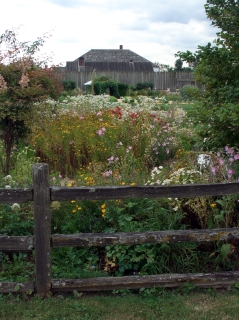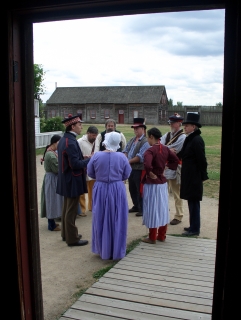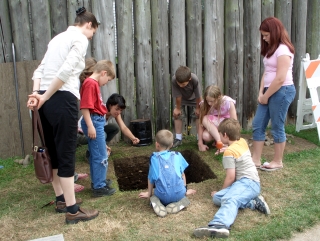NPS Website; Local Website
 WHAT IS IT?
WHAT IS IT?A reconstructed Hudson Bay Company Trading Fort. This British frontier outpost was the center of the northwestern fur trade in the early 19th Century and was, in that time, arguably the most important city in the modern-day western United States.
BEAUTY (4/10)
Visitors pass a fenced garden en route to the Fort’s intimidating palisade. A path splits several square garden plots, some bursting with summer blooms, others cultivating heirloom vegetable and some, sadly, left to the weeds since there aren’t enough staff to hold them back. The garden provides a multicolored foreground to the Fort’s imposing, but otherwise drab, exterior.
Inside the 15-foot palisade, several buildings are reconstructed on their original locations. While not beautiful in themselves, we find beauty in the uniform geometry of the structures and their orderly and linear placement. We really like forts.
The interior of the Chief Factor’s Residence is dressed as if a large dinner party were about to arrive. The Blacksmith Shop and the Bakehouse are completely functional. Fort Vancouver NHS eases the visitor into the 19th century in the Pacific Northwest. No stretches of the imagination are necessary here.
HISTORICAL INTEREST (7/10)
The Hudson Bay Company opened Fort Vancouver in 1818, making it the logistical center of their northwestern fur empire. They intended to consolidate British control of the Oregon Territory and claim the land theirs. Dr. John McLoughlin, a Quebecois, ably ran the business but ultimately was unable to possess the land for the British. The flood of American pioneers foiled the Company’s plans.
The reconstructed Fort presents a perfect opportunity to learn about the fur trade, the business settled the American west. All the buildings have been exactingly furnished and stocked. Fort Vancouver NHS offers the chance, unique to National Park Sites, to watch active archeological digs. You see the hard jobs of digging and sifting and get to talk to the busy workers. In addition, a portion of the Fort’s fur warehouse now houses the archeologists’ offices. A clear plastic panel allows you to watch them work (labeling, typing, writing, thinking) as if they were zoo animals. They must love it.
 CROWDS (8/10)
CROWDS (8/10)Lucky us. We arrived on a weekday that coincided with an Elderhostel trip. As a result, every one of the Fort’s buildings was staffed with period costumed historical interpreters. The Elderhostel group seemed to be a tourist magnet. Hundreds of other visitor ambled from room to room sopping up the wonderful educational afternoon.
Michael had fond memories of his grandmother’s tales of her Elderhostel trip to Tombstone, Arizona. The Elderhostel travelers at Fort Vancouver looked to be having the same terrific time. We were thankful to ride their Ranger-bringing wake.
EASE OF USE/ACCESS (5/5)
Your Pacific Northwest Map is full of things named Vancouver, all named after the same British explorer. This Park is in the United States, in Washington State; its walls overlook the state’s southern boundary, the Columbia River. The bustling city of Portland, Oregon lies just across the water, its downtown only 10 miles from the Fort.
The Park is less than a mile from Interstate 5. Take the Mill Plain Boulevard Exit and either head east (the River will be on your right) or follow the many signs. From Oregon, the Mill Plain Blvd. is the second exit once you enter into Washington. If you are coming from Washington just remember: if you have crossed the Columbia River, you have gone too far.
CONCESSIONS/BOOKSTORE (3/5)
The Rangers’ welcome desk at the Visitor Center doubles as a mock Trading Post. The selection is light but includes dishware, felt hats, bookends and Voyageurs’ cologne. The book selection, too, is a bit sparse, carrying only a few titles concerning the local history.
COSTS (3/5)
Entry is $3 per person or $5 per family. The Site is free with the National Parks Pass. On a Ranger’s suggestion, upon entry we marched straight to the Blacksmith Shop. We watched the smithy twist and turn a piece of pig iron molding it into a neat looking closet hook…, which he gave to Gab! The only thing we need now is a closet.
 RANGER/GUIDE TO TOURIST RATIO (5/5)
RANGER/GUIDE TO TOURIST RATIO (5/5)We were fortunate to experience eleven (!) period-costumed Rangers manning all of the Fort’s buildings. The educators did not stop there. Archeologists, archeology students and more Rangers answered everything we could think up. What a wonderful way to learn. We know that Elderhostel groups do not show up everyday (their trip was a test run at Ft. Vancouver) but we were assured that Rangers always staff at least a few buildings during the summer.
TOURS/CLASSES (9/10)
Thank you, Elderhostel! Because of you, we received top-notch treatment on our tour of the Site. Some of the costumed Rangers, like “Mrs. McLoughlin,” spoke in first person, escorted us around “her” home and spoke lovingly of her husband, the Chief Factor. Others, like the very well informed manager of the fur warehouse gave each group that walked through his wares a thorough history of beaver trapping and trading of skins that extended beyond the timeframe of the fort.
Each building we entered gave us a different yet interlocking perspective of 1845 life in what is now Washington State.
Outside the Fort, university students and non-costumed Rangers were busy sifting through some excavated earth. They were not too busy to explain the excavation process and share with onlookers the bits and pieces of history that they had found that day. On the day of our visit, they unearthed what they thought to be a cistern. All kinds of pottery shards and historical flotsam were emerging from the piles. Exciting stuff for archeology buffs. And kids. And Elderhostel folks. And us.
The Visitors Center, just a short drive (or walk) up the hill from the Fort offers three slide shows shown on request and a small exhibit area. The Fort is where all the fun is.
FUN (8/10)
What is it about forts? The ones that we have visited thus far have all done a superb job at conveying the local history, the larger historical implications of events in and around the fort and engaged us as visitors to ask questions, to learn more.
We thought we knew a lot about Mr. McLoughlin since we visited his house the day before and that we were knowledgeable about the beaver fur trade from our forays into trading forts and voyageur sites back east. Fort Vancouver NHS taught us even more. Learning is fun.
 WOULD WE RECOMMEND? (7/10)
WOULD WE RECOMMEND? (7/10)Our entire afternoon was spent at the Fort Vancouver NHS. We left with a better understanding of Oregon’s ancestors, the role of the Hudson Bay Company in developing the Pacific Northwest and John McLoughlin’s role in facilitating American settlement. Oh yes, and an iron coat hook.
Fort Vancouver NHS is just a short drive from the heart of Portland, a fun city filled with parks. If you find yourself in the northwest corner of the U.S., both merit a visit.
TOTAL 59/80
www.usa-c2c.com
© 2005